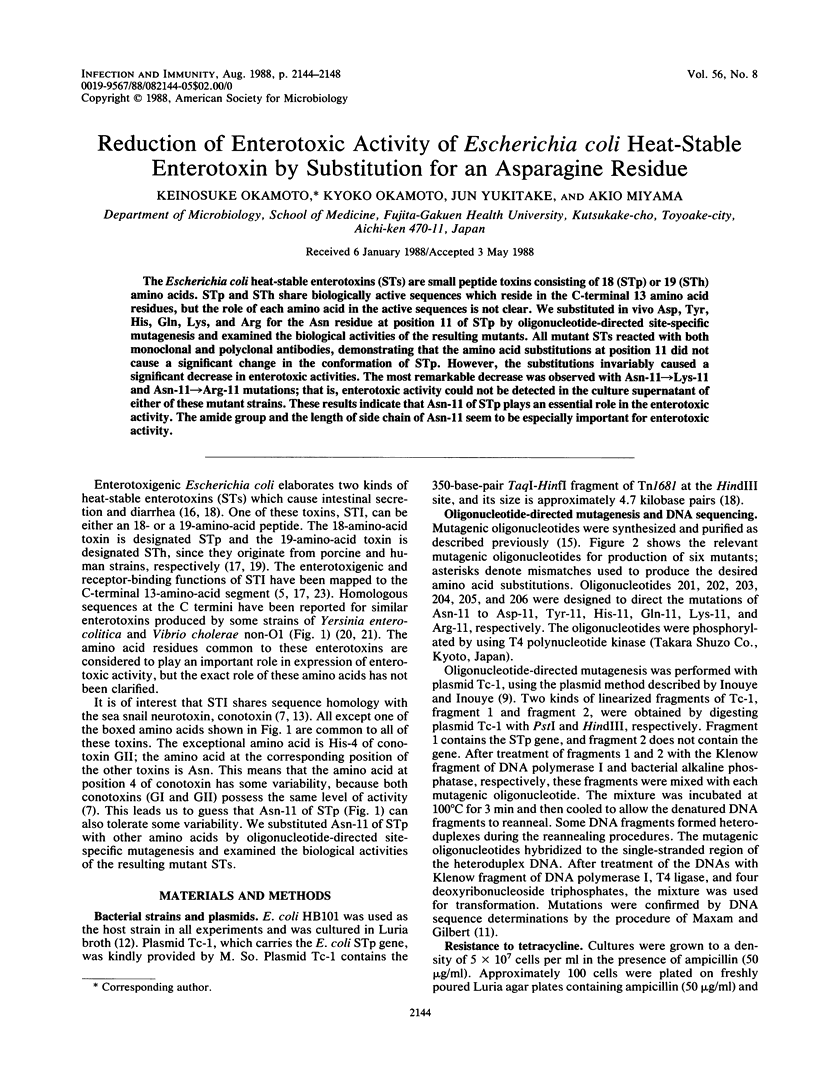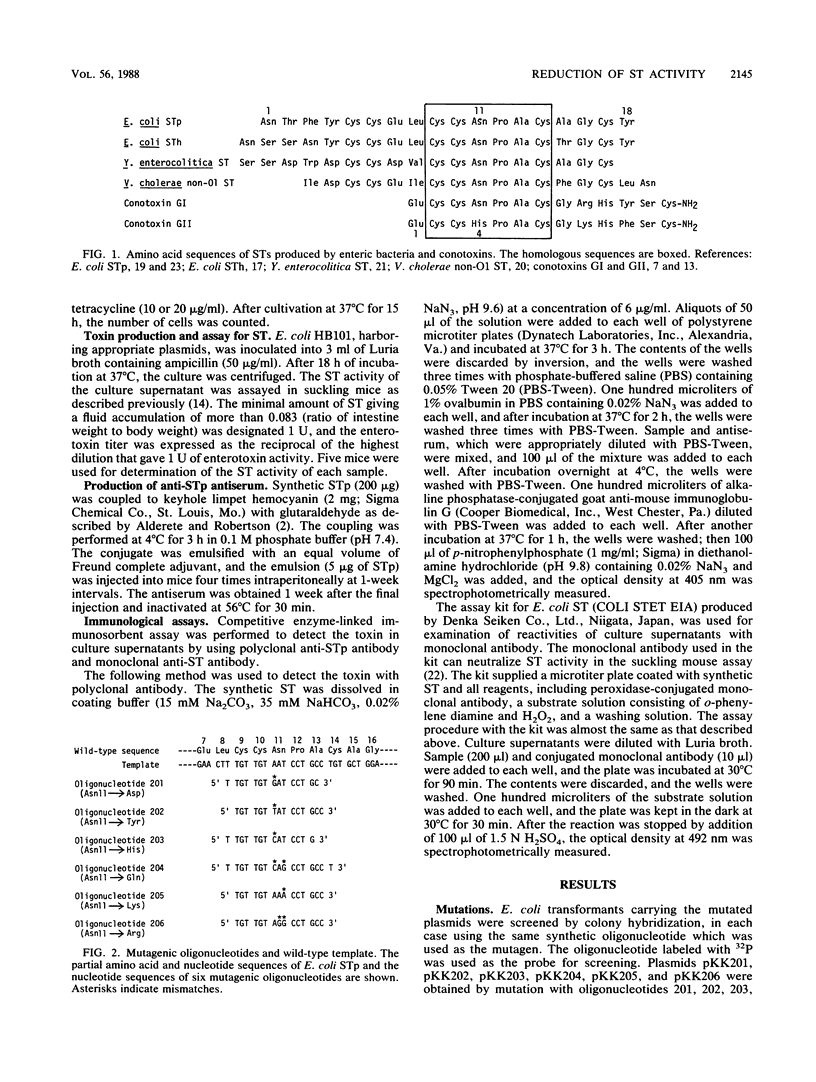Abstract
The Escherichia coli heat-stable enterotoxins (STs) are small peptide toxins consisting of 18 (STp) or 19 (STh) amino acids. STp and STh share biologically active sequences which reside in the C-terminal 13 amino acid residues, but the role of each amino acid in the active sequences is not clear. We substituted in vivo Asp, Tyr, His, Gln, Lys, and Arg for the Asn residue at position 11 of STp by oligonucleotide-directed site-specific mutagenesis and examined the biological activities of the resulting mutants. All mutant STs reacted with both monoclonal and polyclonal antibodies, demonstrating that the amino acid substitutions at position 11 did not cause a significant change in the conformation of STp. However, the substitutions invariably caused a significant decrease in enterotoxic activities. The most remarkable decrease was observed with Asn-11----Lys-11 and Asn-11----Arg-11 mutations; that is, enterotoxic activity could not be detected in the culture supernatant of either of these mutant strains. These results indicate that Asn-11 of STp plays an essential role in the enterotoxic activity. The amide group and the length of side chain of Asn-11 seem to be especially important for enterotoxic activity.
Full text
PDF




Images in this article
Selected References
These references are in PubMed. This may not be the complete list of references from this article.
- Alber T., Sun D. P., Wilson K., Wozniak J. A., Cook S. P., Matthews B. W. Contributions of hydrogen bonds of Thr 157 to the thermodynamic stability of phage T4 lysozyme. Nature. 1987 Nov 5;330(6143):41–46. doi: 10.1038/330041a0. [DOI] [PubMed] [Google Scholar]
- Alderete J. F., Robertson D. C. Purification and chemical characterization of the heat-stable enterotoxin produced by porcine strains of enterotoxigenic Escherichia coli. Infect Immun. 1978 Mar;19(3):1021–1030. doi: 10.1128/iai.19.3.1021-1030.1978. [DOI] [PMC free article] [PubMed] [Google Scholar]
- Bolivar F., Rodriguez R. L., Greene P. J., Betlach M. C., Heyneker H. L., Boyer H. W., Crosa J. H., Falkow S. Construction and characterization of new cloning vehicles. II. A multipurpose cloning system. Gene. 1977;2(2):95–113. [PubMed] [Google Scholar]
- Gariépy J., Lane A., Frayman F., Wilbur D., Robien W., Schoolnik G. K., Jardetzky O. Structure of the toxic domain of the Escherichia coli heat-stable enterotoxin ST I. Biochemistry. 1986 Dec 2;25(24):7854–7866. doi: 10.1021/bi00372a011. [DOI] [PubMed] [Google Scholar]
- Gariépy J., Schoolnik G. K. Design of a photoreactive analogue of the Escherichia coli heat-stable enterotoxin STIb: use in identifying its receptor on rat brush border membranes. Proc Natl Acad Sci U S A. 1986 Jan;83(2):483–487. doi: 10.1073/pnas.83.2.483. [DOI] [PMC free article] [PubMed] [Google Scholar]
- Gray W. R., Luque A., Olivera B. M., Barrett J., Cruz L. J. Peptide toxins from Conus geographus venom. J Biol Chem. 1981 May 25;256(10):4734–4740. [PubMed] [Google Scholar]
- Greenberg R. N., Dunn J. A., Guerrant R. L. Reduction of the secretory response to Escherichia coli heat-stable enterotoxin by thiol and disulfide compounds. Infect Immun. 1983 Jul;41(1):174–180. doi: 10.1128/iai.41.1.174-180.1983. [DOI] [PMC free article] [PubMed] [Google Scholar]
- Kuno T., Kamisaki Y., Waldman S. A., Gariepy J., Schoolnik G., Murad F. Characterization of the receptor for heat-stable enterotoxin from Escherichia coli in rat intestine. J Biol Chem. 1986 Jan 25;261(3):1470–1476. [PubMed] [Google Scholar]
- Maxam A. M., Gilbert W. A new method for sequencing DNA. Proc Natl Acad Sci U S A. 1977 Feb;74(2):560–564. doi: 10.1073/pnas.74.2.560. [DOI] [PMC free article] [PubMed] [Google Scholar]
- Nishiuchi Y., Sakakibara S. Primary and secondary structure of conotoxin GI, a neurotoxic tridecapeptide from a marine snail. FEBS Lett. 1982 Nov 8;148(2):260–262. doi: 10.1016/0014-5793(82)80820-x. [DOI] [PubMed] [Google Scholar]
- Okamoto K., Inoue T., Ichikawa H., Kawamoto Y., Miyama A. Partial purification and characterization of heat-stable enterotoxin produced by Yersinia enterocolitica. Infect Immun. 1981 Feb;31(2):554–559. doi: 10.1128/iai.31.2.554-559.1981. [DOI] [PMC free article] [PubMed] [Google Scholar]
- Okamoto K., Okamoto K., Yukitake J., Kawamoto Y., Miyama A. Substitutions of cysteine residues of Escherichia coli heat-stable enterotoxin by oligonucleotide-directed mutagenesis. Infect Immun. 1987 Sep;55(9):2121–2125. doi: 10.1128/iai.55.9.2121-2125.1987. [DOI] [PMC free article] [PubMed] [Google Scholar]
- Picken R. N., Mazaitis A. J., Maas W. K., Rey M., Heyneker H. Nucleotide sequence of the gene for heat-stable enterotoxin II of Escherichia coli. Infect Immun. 1983 Oct;42(1):269–275. doi: 10.1128/iai.42.1.269-275.1983. [DOI] [PMC free article] [PubMed] [Google Scholar]
- Shimonishi Y., Hidaka Y., Koizumi M., Hane M., Aimoto S., Takeda T., Miwatani T., Takeda Y. Mode of disulfide bond formation of a heat-stable enterotoxin (STh) produced by a human strain of enterotoxigenic Escherichia coli. FEBS Lett. 1987 May 4;215(1):165–170. doi: 10.1016/0014-5793(87)80134-5. [DOI] [PubMed] [Google Scholar]
- So M., McCarthy B. J. Nucleotide sequence of the bacterial transposon Tn1681 encoding a heat-stable (ST) toxin and its identification in enterotoxigenic Escherichia coli strains. Proc Natl Acad Sci U S A. 1980 Jul;77(7):4011–4015. doi: 10.1073/pnas.77.7.4011. [DOI] [PMC free article] [PubMed] [Google Scholar]
- Takao T., Hitouji T., Aimoto S., Shimonishi Y., Hara S., Takeda T., Takeda Y., Miwatani T. Amino acid sequence of a heat-stable enterotoxin isolated from enterotoxigenic Escherichia coli strain 18D. FEBS Lett. 1983 Feb 7;152(1):1–5. doi: 10.1016/0014-5793(83)80469-4. [DOI] [PubMed] [Google Scholar]
- Takao T., Shimonishi Y., Kobayashi M., Nishimura O., Arita M., Takeda T., Honda T., Miwatani T. Amino acid sequence of heat-stable enterotoxin produced by Vibrio cholerae non-01. FEBS Lett. 1985 Dec 2;193(2):250–254. doi: 10.1016/0014-5793(85)80163-0. [DOI] [PubMed] [Google Scholar]
- Takao T., Tominaga N., Yoshimura S., Shimonishi Y., Hara S., Inoue T., Miyama A. Isolation, primary structure and synthesis of heat-stable enterotoxin produced by Yersinia enterocolitica. Eur J Biochem. 1985 Oct 1;152(1):199–206. doi: 10.1111/j.1432-1033.1985.tb09183.x. [DOI] [PubMed] [Google Scholar]
- Thompson M. R., Giannella R. A. Revised amino acid sequence for a heat-stable enterotoxin produced by an Escherichia coli strain (18D) that is pathogenic for humans. Infect Immun. 1985 Mar;47(3):834–836. doi: 10.1128/iai.47.3.834-836.1985. [DOI] [PMC free article] [PubMed] [Google Scholar]



